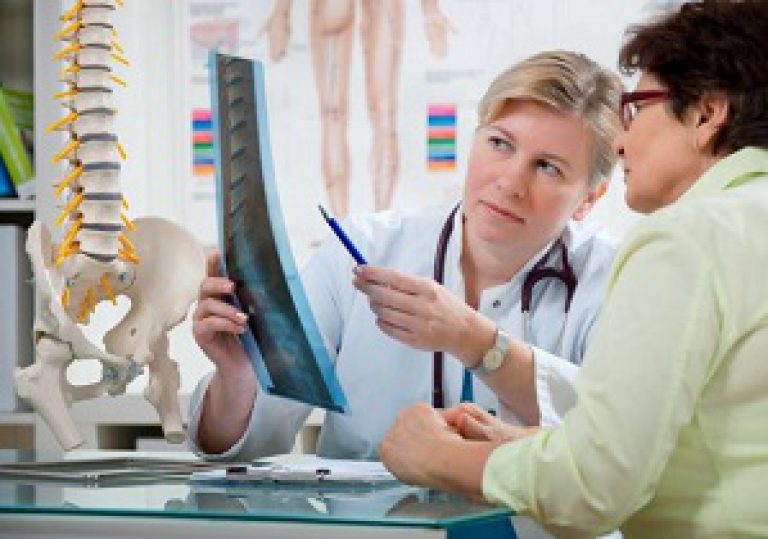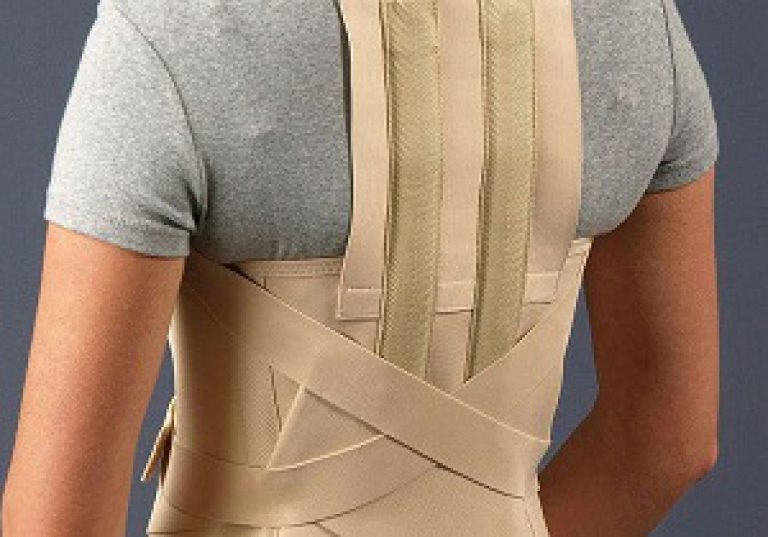How to correct a curvature of the spine: effective treatment options. Video - Types of curvature of the spine.
Curvature of the spine - a violation in the formation of natural physiological curves of the spine. In the process of development of the human body, four bends are formed - thoracic, cervical and lumbar, sacral kyphosis. Due to certain pathological processes or due to trauma, additional bends or a violation in the natural physiological curvature may form. In this case, you should contact medical care. It is impossible to ignore the problem, as this is fraught with the development of serious complications.
The reason is unknown. Depending on the age of what is happening, they are divided into. Scoliosis Scoliosis neuromuscular paralytic rheumatic scoliosis - caused by an imbalance of the paravertebral muscles, caused by various neurological diseases. Congenital scoliosis - caused by developmental disorders of the vertebrae during fetal life. Post-traumatic myopathic scoliosis scoliosis - scoliosis is secondary to muscle disease that affects the muscles of the spine. Scoliosis from tumors of the spinal cord.
- Infantile scoliosis. juvenile scoliosis.
- Adolescent scoliosis.
- Scoliosis lopsided - caused by muscle weakness.
Etiology
The etiological causes of spinal curvature are divided into two groups - acquired and congenital. Congenital factors include the following:
- genetic abnormalities that have become a provoking factor in the pathologies of the connective tissue of the spine;
- hereditary predisposition;
- ailments that lead to metabolic and dystrophic disorders;
- congenital pathologies of the central nervous system.
Acquired etiological factors include:
Treatment is complex, orthopedic - surgical and rehabilitation through. The purpose of the exercise is to correct the curvature of the spine, pelvis and balance the restoration of the shoulder girdle. Treatment with physiotherapy aims to stop the scoliosis, the spine, to correct deviations and maintain this correction, to reduce the secondary asymmetry of functional disorders and the body.
Causes and contributing factors in case of column deficiencies. Incorrect position of the child seat in the first years of life, both at home and in kindergarten or school and backpack misdeeds can eventually lead to those unwanted backbones. Other reasons, such as a sudden increase in height, prohibiting regular sports or physical therapy that strengthens the back muscle, contribute to maintaining or worsening the deformity of the spine in which the disease was established. It is very important to detect these column deficiencies from an early age, because exercising correctly can have very good results, which can lead to permanent correction of deficiencies.
- muscle inflammation;
- injuries of the spine or other part of the musculoskeletal system;
- prolonged with unilateral localization. For example, with kidney disease, education;
- muscle tension, which may be due to the formation of deep scars of soft tissues;
- Scheuermann-Mau syndrome - curvature of the spine in the thoracic region;
- pathological lordosis and kyphosis;
In addition, the curvature of the cervical spine may be due to the specifics of human life - sedentary work in an uncomfortable or improperly selected chair can also lead to curvature of the spine and related pathologies.
In these cases, a specialist doctor will diagnose after consultation, and a physiotherapist will develop a program of corrective exercises. Undiagnosed and untreated disease over time will lead to irreversible changes in the spine that can only be resolved by surgery.
This leads to a change in the activity of the entire locomotor system, respiratory movements, which will cause changes in metabolism, the balance of the endocrine glands or the nervous system. Treatment of medical gymnastics is aimed at stopping the evolution of scoliosis, eliminating spinal deviations and maintaining this correction, reducing functional disorders and secondary asymmetries of the body.
Lateral curvature of the spine is called. This is one of the most common pathologies, especially among adolescents.
Classification
Clinicians distinguish the following types of curvature of the spine:
- scoliosis - lateral pathological bend;
- lordosis - pathological forward bend;
- kyphosis is an abnormal backward bend.
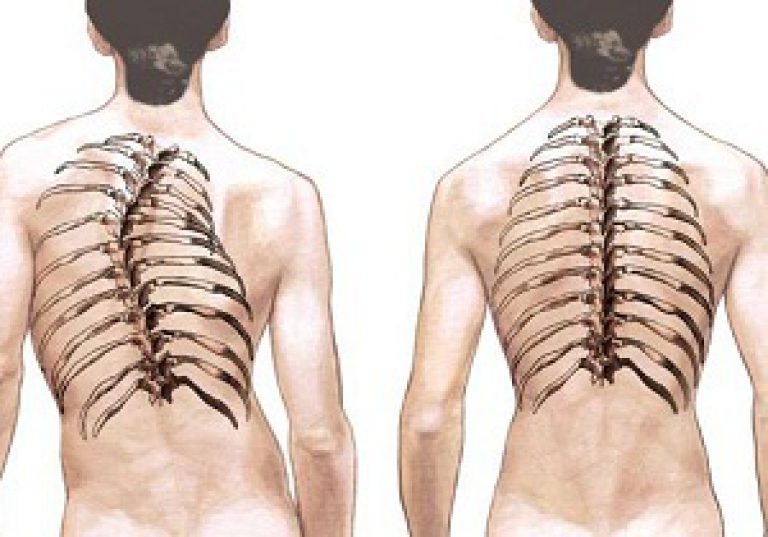
Gabriela Nedel, chief physiotherapist. As for the treatment of unstructured scoliosis, it is simple and consists of: therapeutic gymnastics while resting on the bed in a hard trunk position at school and at home, check for impaired hearing and vision, sports that require moderate effort. In case of inequality of the lower extremities, the orthopedist will take measures to equalize them, if necessary, by adding, for example, a boot heel. The use of orthopedic corsets is contraindicated.
The treatment of scoliosis itself, however, is more complicated and difficult, therefore, depending on the age and clinical form. In general, the treatment of various forms of scoliosis is similar. In the case of a more pronounced curve, below 50º, a change in treatment, the child requires hospitalization; intermittent. In addition to therapeutic gymnastics associated with delayed and orthopedic procedures. In this respect, as applied in the case, or plaster corsets right, while about 6 months or plastic orthopedic corsets.
In turn, kyphosis is distinguished by the following types:
- arcuate - smooth rounded deformation of the intervertebral discs;
- angular - protrusion of the corners of one or more intervertebral discs.
Somewhat less often, and only as a complication, a mixed form of several types of curvature of the spine occurs.
In this corset, the child goes to school, eat, sleep, take it only 2 hours a day for general hygiene. It is surprising how quickly children adapt to this situation, and not parents, who often weaken the impression of control of the treatment. The operation consists in restoring the curvature by stretching the spine, an orthopedic maneuver performed on a table, and the stretching effect of a metal device attached to the vertebrae. After obtaining the necessary correction, resorting to fixing the zone of the corresponding vertebra using bone implants.
The development of this pathological process is also distinguished according to the stages of development:
- first degree - the angle of the arc of curvature is not more than 10 degrees. At this stage, there are no special external changes, the patient does not complain of feeling unwell;
- second degree - bending angle from 10 to 25 degrees. With prolonged physical exertion, the patient complains of back pain;
- third degree - the angle of curvature varies from 26 to 50 degrees, the deformations are clearly expressed. Shortness of breath both during physical activity and at rest. Almost always there are pain attacks in the muscles;
- fourth degree - not less than 50 degrees. In this case, there are problems with the functioning of the cardiovascular system, gastrointestinal tract, upper respiratory system. The physical activity of a person is minimal, since any movement provokes severe pain.
It should be noted that at the last stage of development of this type of vertebral deformities, massage and exercises will no longer be enough. Therefore, you need to seek medical help in a timely manner, and not self-medicate.
After the operation, the child is held in a plaster corset, and then orthopedic to unity. Surgery is the most satisfactory results, allowing corrections to 50º curvature, then the child can integrate almost normal into Everyday life. In conclusion, the treatment of scoliosis, although long and difficult, with some complications and unsatisfactory results, the results are superior to other times. Therapeutic success is ensured and close cooperation between physicians and all those who care for the child. Kyphosis is another spinal deformity caused by a deviation in the median plane with a physiological dorsal curvature exaggerated. Get to know the different forms of kyphosis, but the most common age belongs to the heading for teenage children. At school, on the playground, or at home, teachers or parents may have a nasty surprise to see some children more prominently rear. In this case, the doctor will distinguish between two disorders. By analogy with the attitude of scoliosis, the vertebrae do not show any pathological changes, this form of kyphosis occurs in a general growth imbalance. Treatment will consist of gymnastics and medically hardened, hard bedding, no pillow under the head, self binding, avoidance of exercise, general treatment, etc. Another distinct attachment relates to the juvenile cyst or vertebral epithelium that occurs during puberty, especially in boys.
Symptoms
The general clinical picture will be supplemented by specific signs, the nature of which will depend on the localization of the pathological process. You can notice the curvature of the spine in children or adults by the following signs:
- if a person stands straight and one shoulder is higher than the other;
- on physical examination of the back, a protruding scapula is clearly visible;
- when tilted, a clear curvature is visualized.
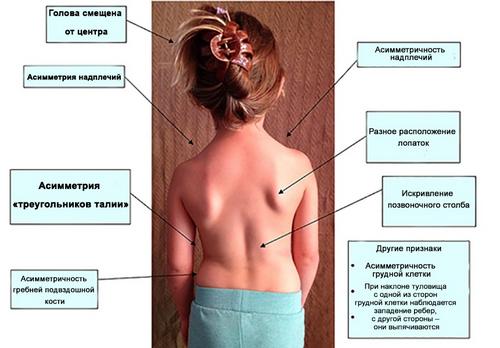
The therapeutic agent refers to the severity of the disease
The resulting curve or cybus is constantly intensifying due to gravitational forces that overload the column in orthostatic. From the foregoing, it is clear that it is necessary to timely identify various deviations of the spine from surrounding children. Only in this case can be applied to an orthopedic specialist for proper treatment, able to correct unsightly aspects and prevent serious functional complications that will ultimately endanger the child's health.
Subjective clinical signs of curvature of the spine include:
- attacks of pain with localization in the back, chest, cervical region, which increase even with minimal exercise;
- numbness of hands and feet;
- muscle weakness;
- with localization in the lumbar region, sexual dysfunction in men and ovarian dysfunction in women;
- deterioration in the functioning of the musculoskeletal system;
At the last stage of the development of the disease, in the clinical picture of which there is this symptom, it is possible to show signs of the clinical picture of cardiovascular, gastroenterological pathologies, and diseases of the genitourinary system.
Articles on the theme. Related articles. Spinal changes in the vertebrae in athletes - aspects of radio imaging. Anne-Marie Zamfir National Institute of Sports Medicine, Bucharest. Annotation. Key words: spine, athletes, radio image. The diversity and multitude of sports, the many young people who practice them, and the special requests required today to achieve performance have led to a certain pathology of the sport.
Statistical data indicate a close relationship between the number and type of sports injuries and the characteristics of sports disciplines. The type of effort, its biomechanical characteristics, the technique and equipment used, the environmental and organizational conditions that take place in sports training and competition are the main reasons that change the percentage of sports injuries, their place and how.
It should be understood that only a doctor can tell how to cure the curvature of the spine correctly. Self-treatment, especially with the use of exercise therapy exercises or massage, can only aggravate the pathology, which will lead to the development of serious complications, including complete paralysis.
Diagnostics
First of all, the doctor conducts a thorough physical examination. To confirm the diagnosis, the following laboratory and instrumental diagnostic methods can be prescribed:
Radiologically, the most common is linear or wide translucency, with vertebral lobes that are spaced or completely absent. It defines static rhinitis, often unilateral. This is best shown on X-ray radiographs at ¾ frequency, the Kovacs technique: the semi-arc configuration of the posterior arch is compared to a "puppy". An elongated or broken isthmus results in a long-necked or collared dog. Sometimes spondylolysis occurs only when it is complicated by spondylolysis.
- general and biochemical blood tests;
- ultrasound examination of internal organs;
- radiography.
In general, the diagnostic program, as well as treatment, is prescribed individually, depending on the current clinical picture, general condition health and age of the patient.
Treatment
Treatment of curvature of the spine in a child or adult should be strictly under the supervision of a physician. Basic therapy is selected based on the diagnosis. Almost always, treatment includes a course of exercise therapy. In advanced stages, surgical intervention is carried out.
The base underlying the lesion narrows, suffers from degenerative changes over time, especially in athletes where column demands are high. Orthostatic radiographs are preferred because the main focus is accentuated. The degree of displacement of the vertebrae is assessed according to the Ullmann scheme.
To determine the congenital or post-traumatic nature of spondylolisthesis, radiographs taken at the beginning of sports activity at an early age are necessary. I had a case of spondylolysis spondylolysis in a 7 year old gymnast who had no clinical signs of spinal suffering, the discovery was accidental.
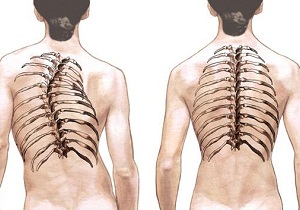
Medical therapy includes the following:
- painkillers;
- chondroprotectors;
- non-steroidal anti-inflammatory drugs;
- vitamin complexes.
As additional medical measures, special exercises for curvature of the spine, massage, and manual therapy courses are prescribed.
Spinal changes characteristic of sports include traumatic lesions of the spine, microtraumatism and chronic conditions, the consequences of micro- and macrotraumatism. Most injuries associated with sports activities are associated with the limbs of the body - acute or chronic lesions of the limbs. Approximately 5% of acute lesions involve the spine. Of all the cracks, the fracture of the column is about 0.5-1%. Swimming, horseback riding, and parachuting provide the highest percentage of column fractures.
Sports are the fourth cause of vertebral fractures and the second cause of associated paralysis. As a general classification, we note the traumatic lesions of the column. Diseases of the bone marrow and cerebral traumatic disorders of lesions of the soft paravertebral parts. Spine injury with neurological distress nuclear magnetic resonance examination shows disruption of the bone marrow, bone or disc due to compression, ligament injury, associated kiln stability lesions, but small bone fragments are visible and no gaps in the past.
You can correct the curvature of the spine at home only on initial stages deformations through the following measures:
- elimination of physical stress;
- development of correct posture;
- arrangement of the right workplace - the chair should be not only comfortable, but also correct, from the point of view of physiology.
A set of exercises that can be done at home should be agreed with your doctor.
Computed tomography is the examination of choice in bone balance, especially in vertebral vertebral artery fractures, intracanal separated vertebral fractures, and acute hematoma. Microtrauma disease includes injury due to overload caused by traumatic agents of low intensity, but is often repetitive, exceeding the potential for tissue regeneration in question and obtaining anatomical microscopic. For example, when the total surface area is small, but frequent compression causes swelling of the cartilage, followed by erosion and necrosis of the cancellous bone.
Prevention
It is much easier to avoid pathological curvature of the spine than to eliminate the consequences of such a pathological process and related ailments. There are no specific preventive measures, since this is a symptom, and not a separate disease. To prevent such a pathology, preventive measures regarding etiological factors should be put into practice.
The symptomatology of these conditions is the occurrence of pain associated with physical effort, progressive pain, although they also have periods of remission. The disease often affects athletes who practice water sports, especially canoeing and diving. Clinically manifested by pain in the spinous, especially in the lumbar region, the pain is aggravated by the expansion of the column and palpation of the spinous. The sport is more common in those who practice gymnastics, athletics and sports games.
Especially affects the spine. There, the lumbar form of the disease is most often associated with trauma and backache. It occurs in athletes who practice gymnastics, football and tennis. Symptoms of pain in the region of the spine, acute states of effort are marked by fatigue and the appearance of kyphosis. Sometimes, lymph substance hernia can create gaps in the previous angle of displacement of the vertebral bodies or bony marginal sections of the ridge, radiographic appearance of a crack.
"Curvature of the spine" is observed in diseases:
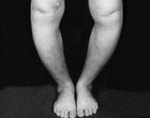
A person with a beautiful posture is not only self-confident, but also a model right image life. Obesity, sedentary work, weakening of the spinal muscles and much more can cause spinal curvature. As a result, a person becomes stooped, unsure of himself, he is tormented by back pain. Therefore, it is important to start curvature prevention as early as possible. And if such a pathology is already present, take all measures to correct posture.
Reasons for the development of pathology

The irregular shape of the spinal column can be either a congenital anomaly or acquired. The reasons for these distortions are different.
Basic forms:
- hereditary inclination and genetic abnormalities;
- congenital diseases of the central nervous system;
- metabolic and dystrophic disorders in the body (rickets,);
- neoplasms in the spine;
- trauma;
- bone tuberculosis;
- myositis.
In childhood, the spine has a weak muscular corset, and with regular correct position body changes its shape. Curvature of the spinal column in adulthood occurs against the background of long-term developing diseases, such as, for example, or.
Types of pathology
Normally, a person has 4 natural bends in the spine: in the area of the sacrum, cervical region, in the lumbar and in the thoracic region. Curvature - abnormal deviations of the bends from the natural axis of the spinal column in one direction or another.
- Arcuate - the arc of curvature is uniform.
- Angular - the formation of an angle from several adjacent vertebrae.
Lordosis
Deviation of the spine in front. Often formed in the lumbar and cervical spine. With the lumbar, the mobility of the legs may be disturbed, with the cervical - the mobility of the shoulder girdle, frequent headaches appear.
The first signs and degrees of development
Symptoms of pathology in its various types depend on the location and degree of curvature of the spinal column:
- 1 degree difficult to determine with the naked eye. The curvature has the appearance of a normal stoop. Externally, there is asymmetry of the buttocks and shoulders, lowering the head down, bringing the shoulders forward. The arc angle does not exceed 10 o.
- 2 degree characterized by an increase in the curvature of the arc from 10 to 25 o. The contours of the waist and neck are asymmetrical. The ribs protrude towards the curvature. Physical activity is difficult, with prolonged sitting, back pain appears.
- 3 degree– the angle of curvature can reach up to 50 o. The rib hump, muscle contractures are striking. There are spasms in the spinal muscles. Even small physical activities are difficult.
- 4 degree– the angle of the arc exceeds 50 o. The deformation is strongly pronounced. This greatly affects the functionality of internal organs.
Note! Symptoms of the anomaly largely depend on the location of its localization. If crooked lumbar of the spine, motor disorders of the lower extremities appear, a disorder of the functions of the genital organs is possible. Pathology in the cervical region leads to frequent headaches, dizziness.
Diagnostics
Deformation of the spinal column can be determined by external examination of the patient. You can assume that you have a curvature on your own:
- When standing straight, the position of one shoulder is lower than the second.
- The shoulder blades do not protrude equally when standing.
- Different distance from arms to waist.
The diagnosis can be confirmed by such methods as computed tomography, radiography, MRI.
Curvature Correction Techniques
In stationary conditions, the spine is corrected only in case of surgery. In other cases, many recommendations of a specialist can be performed at home.
During treatment, the patient should:
- eliminate large loads on the spine;
- work on the formation of correct posture;
- strengthen the muscular corset;
- eliminate secondary signs of pathology.
There are many methods of treating curvature of the spine. Before you start using any of them, you need to find out the cause of the pathology and the degree of its complexity.
In adulthood, you can independently correct the curvature of the 1st degree with regular performance of the necessary exercises. At grade 2, it is necessary to include a set of additional measures in the treatment. In addition to exercises, massage courses and manual therapy are used. In children, correcting the position of the spinal column is easier than in adults. 3 and 4, the degree of curvature cannot be completely eliminated. But so that the deformation of the spine does not occur further, it is necessary to carry out all the procedures prescribed by the doctor.
How to treat curvature of the spine? To correct posture, use:
- medical gymnastics;
- massage;
- manual therapy;
- swimming;
- orthotics;
- reflexology.
In the last stages of the curvature, if the normal functioning of the body is disturbed, surgical intervention is performed.
Massotherapy
This is one of the most used methods of treatment. Helps to normalize muscle tone, strengthen them, stimulates blood circulation. The massage is performed in correct sequence. First, the back is massaged, then the lower back and gluteal muscles, and finally the chest and abdomen.
With a curvature of 2-3 degrees, a differentiated massage is performed. Different techniques are selectively applied in certain areas. A tonic massage is needed in the area of the curvature arc. First, the area is intensively rubbed, then stroking, pressing, tapping with fingertips is carried out.
Back exercises
A set of exercises is aimed at strengthening the spinal muscles. This makes it possible to keep the spine in the correct position. There is different types and degree of curvature. Therefore, before starting classes, the doctor must draw up an exercise program that is suitable in each case.
LFK rules:
- The load in the classroom should increase gradually.
- The number of approaches to adjust depending on the well-being of the person.
- Alternate loads on different muscle groups.
- Refuse exercises in which there is hyperextension of the back and vertical rotations.
Go to the address and read about what is rheumatic fever and how to treat the disease.
- Starting position standing. Pull the body up, at the same time raise your arms up. Stay like this for a few seconds. Repeat 20-30 sets.
- Spread your legs shoulder width apart. Tilt the torso alternately to the right, then to the left.
- Lie down on your stomach. Stretch arms and legs alternately up.
- Get on all fours. As you exhale, arch your back with a wheel (cat pose). Hold for a few seconds, while inhaling, return to the starting position.
If you systematically perform exercise therapy, then in a few years you can completely get rid of the curvature of the 1st and 2nd degree. With progressive scoliosis, classes should be strictly controlled by a doctor. Therefore, they need to be carried out in specialized institutions.
Orthotics
To correct posture, special devices (orthoses) are additionally used. Various belts and corsets help redistribute the load on the spine, act on the lateral points of the arc. To achieve the effect of the use of orthoses, they must be worn for several hours a day for several years.
Orthosis also has its downsides. A corset or belt takes the load off the spine. Subsequently, this leads to a weakening of the spinal muscles. When removing the orthosis, the process can only get worse. Therefore, the wearing of such devices must necessarily be combined with regular exercise therapy.
Tips for preventing curvature of the spine in children:
- Correctly select the height of the table and chair for the child. Elbows should be placed slightly above table level.
- The child must sit correctly at the desk. Keep your back straight, feet touching the ground, elbows on the table.
- Swimming, exercise.
- Do not lift more than 20 kg for women, and more than 50 kg for men.
- Don't sit in one position for a long time. Take breaks for 5-7 minutes.
- Avoid constant tilting during various work. If you need to lift something, you need to sit down slightly, but do not bend over.
- To reduce the load on the vertebrae when lifting weights, they need to be held closer to the body.
Curvature of the spine entails a number of unpleasant consequences. This is not only stoop and distortion of the body, but also a deterioration in the functioning of internal organs, difficulty breathing, and headaches. Therefore, it is important not to miss the early stages of the development of pathology and not leave it unattended. To form the correct posture, it is necessary to carry out the prevention of curvature from early childhood. The basis of human health is a healthy spine.
Video - a lesson on maintaining your spine health and preventing curvature:
Attention! Only today!
